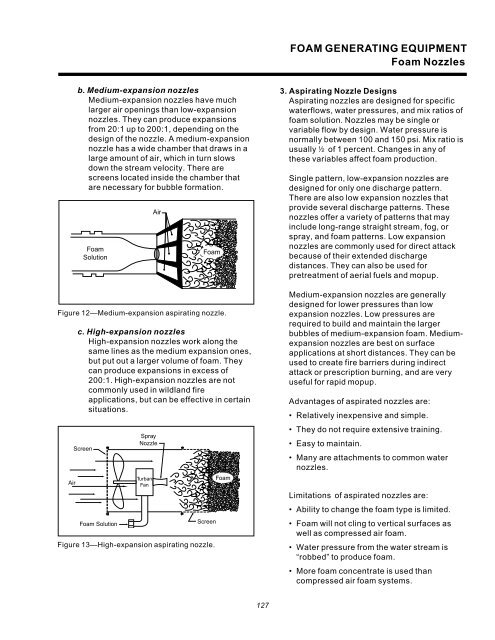Water Handling Equipment Guide - National Wildfire Coordinating ...
Water Handling Equipment Guide - National Wildfire Coordinating ...
Water Handling Equipment Guide - National Wildfire Coordinating ...
Create successful ePaper yourself
Turn your PDF publications into a flip-book with our unique Google optimized e-Paper software.
FOAM GENERATING EQUIPMENT<br />
Foam Nozzles<br />
b. Medium-expansion nozzles<br />
Medium-expansion nozzles have much<br />
larger air openings than low-expansion<br />
nozzles. They can produce expansions<br />
from 20:1 up to 200:1, depending on the<br />
design of the nozzle. A medium-expansion<br />
nozzle has a wide chamber that draws in a<br />
large amount of air, which in turn slows<br />
down the stream velocity. There are<br />
screens located inside the chamber that<br />
are necessary for bubble formation.<br />
Figure 12—Medium-expansion aspirating nozzle.<br />
Air<br />
Foam<br />
Solution<br />
c. High-expansion nozzles<br />
High-expansion nozzles work along the<br />
same lines as the medium expansion ones,<br />
but put out a larger volume of foam. They<br />
can produce expansions in excess of<br />
200:1. High-expansion nozzles are not<br />
commonly used in wildland fire<br />
applications, but can be effective in certain<br />
situations.<br />
Screen<br />
Foam Solution<br />
Air<br />
Spray<br />
Nozzle<br />
Turban<br />
Fan<br />
Foam<br />
Screen<br />
Figure 13—High-expansion aspirating nozzle.<br />
Foam<br />
3. Aspirating Nozzle Designs<br />
Aspirating nozzles are designed for specific<br />
waterflows, water pressures, and mix ratios of<br />
foam solution. Nozzles may be single or<br />
variable flow by design. <strong>Water</strong> pressure is<br />
normally between 100 and 150 psi. Mix ratio is<br />
usually 2 of 1 percent. Changes in any of<br />
these variables affect foam production.<br />
Single pattern, low-expansion nozzles are<br />
designed for only one discharge pattern.<br />
There are also low expansion nozzles that<br />
provide several discharge patterns. These<br />
nozzles offer a variety of patterns that may<br />
include long-range straight stream, fog, or<br />
spray, and foam patterns. Low expansion<br />
nozzles are commonly used for direct attack<br />
because of their extended discharge<br />
distances. They can also be used for<br />
pretreatment of aerial fuels and mopup.<br />
Medium-expansion nozzles are generally<br />
designed for lower pressures than low<br />
expansion nozzles. Low pressures are<br />
required to build and maintain the larger<br />
bubbles of medium-expansion foam. Mediumexpansion<br />
nozzles are best on surface<br />
applications at short distances. They can be<br />
used to create fire barriers during indirect<br />
attack or prescription burning, and are very<br />
useful for rapid mopup.<br />
Advantages of aspirated nozzles are:<br />
• Relatively inexpensive and simple.<br />
• They do not require extensive training.<br />
• Easy to maintain.<br />
• Many are attachments to common water<br />
nozzles.<br />
Limitations of aspirated nozzles are:<br />
• Ability to change the foam type is limited.<br />
• Foam will not cling to vertical surfaces as<br />
well as compressed air foam.<br />
• <strong>Water</strong> pressure from the water stream is<br />
“robbed” to produce foam.<br />
• More foam concentrate is used than<br />
compressed air foam systems.<br />
127
















